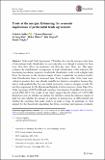| dc.contributor.author | Spilker, Gabriele | |
| dc.contributor.author | Bernauer, Thomas | |
| dc.contributor.author | Kim, In Song | |
| dc.contributor.author | Milner, Helen | |
| dc.contributor.author | Osgood, Iain | |
| dc.contributor.author | Tingley, Dustin | |
| dc.date.accessioned | 2018-04-10T19:46:05Z | |
| dc.date.available | 2018-04-10T19:46:05Z | |
| dc.date.issued | 2018-04 | |
| dc.identifier.issn | 1559-7431 | |
| dc.identifier.issn | 1559-744X | |
| dc.identifier.uri | http://hdl.handle.net/1721.1/114654 | |
| dc.description.abstract | Preferential Trade Agreements (PTAs) have become the most prevalent form of international trade liberalization in recent decades, even though it remains far from clear what their effects on economies and their key units, firms, are. This paper evaluates the distributional consequences of trade liberalization within industries differentiating two distinct aspects in which trade liberalization could result in higher trade flows: the intensive vs. the extensive margin of trade. In particular, we analyze whether trade liberalization leads to increased trade flows because either firms trade more volume in products they have already traded before (intensive margin) or because they start to trade products they have not traded previously (extensive margin), or both. We test these arguments for the Dominican Republic–Central America–United States Free Trade Agreement (CAFTA-DR) and exporting firms based in Costa Rica for the time-period 2008–2014. The results of our study suggest that the effects of CAFTA-DR depend not only on whether we analyze the extensive versus the intensive margin of trade but also whether the product in question is homogenous or differentiated and whether the exporting firm under analysis is small or large. In particular, we find support for the theoretical expectation that firms exporting heterogeneous products, such as textiles, gain from trade agreements, such as CAFTA-DR, in that they can export more varieties of their products. Yet at the same time, they tend to lose at the intensive margin by a reduction in their trade volume while the opposite pattern occurs for firms exporting homogenous products. Keywords: Preferential trade agreements; Product differentiation; Extensive margin of trade; Intensive margin of trade | en_US |
| dc.publisher | Springer-Verlag | en_US |
| dc.relation.isversionof | https://doi.org/10.1007/s11558-018-9306-7 | en_US |
| dc.rights | Creative Commons Attribution | en_US |
| dc.rights.uri | http://creativecommons.org/licenses/by/4.0/ | en_US |
| dc.source | Springer US | en_US |
| dc.title | Trade at the margin: Estimating the economic implications of preferential trade agreements | en_US |
| dc.type | Article | en_US |
| dc.identifier.citation | Spilker, Gabriele et al. “Trade at the Margin: Estimating the Economic Implications of Preferential Trade Agreements.” The Review of International Organizations (April 2018): 1-54 © 2018 The Author(s) | en_US |
| dc.contributor.department | Massachusetts Institute of Technology. Department of Political Science | en_US |
| dc.contributor.mitauthor | Kim, In Song | |
| dc.relation.journal | The Review of International Organizations | en_US |
| dc.eprint.version | Final published version | en_US |
| dc.type.uri | http://purl.org/eprint/type/JournalArticle | en_US |
| eprint.status | http://purl.org/eprint/status/PeerReviewed | en_US |
| dc.date.updated | 2018-04-10T03:53:29Z | |
| dc.language.rfc3066 | en | |
| dc.rights.holder | The Author(s) | |
| dspace.orderedauthors | Spilker, Gabriele; Bernauer, Thomas; Kim, In Song; Milner, Helen; Osgood, Iain; Tingley, Dustin | en_US |
| dspace.embargo.terms | N | en_US |
| dc.identifier.orcid | https://orcid.org/0000-0002-5774-1585 | |
| mit.license | PUBLISHER_CC | en_US |
